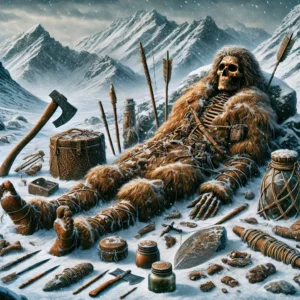Ötzi: The Frozen Man of the Past
In 1991, a stunning archaeological discovery was made high in the Ötztal Alps, forever changing our understanding of prehistoric life. A mummified body, astonishingly well-preserved, was unearthed by hikers. Nicknamed “Ötzi,” this ancient man lived over 5,000 years ago during the late Neolithic period (approximately 3400–3100 BC). Since his discovery, Ötzi has provided researchers with a wealth of information about the life, culture, and challenges of his time.
Ötzi’s preservation is a remarkable feat of nature. Following his death, his body was dehydrated and naturally mummified in the glacial ice. This process not only protected his remains but also preserved the materials he carried, offering an extraordinary glimpse into his daily life.
When Ötzi’s body was recovered, a trove of items surrounded him. These included fragments of leather, fur, and braided grass that were identified as pieces of his clothing. He wore a coat, belt, trousers, a loincloth, and shoes—crafted with remarkable ingenuity for the era. His cap was made from bearskin, and the shoes were lined with hay to provide insulation in the harsh Alpine climate.
In addition to his clothing, Ötzi carried tools and weapons, including a copper axe, a flint dagger, a bow, and a quiver with two arrows ready for use alongside twelve unfinished shafts. These items point to his survival skills and his ability to hunt. Remains of a backpack and birch bark containers, one containing traces of maple leaves and charcoal, were also recovered.
Analysis of Ötzi’s stomach contents revealed a diverse diet. He had consumed grains, plants, fruits, and meat before his death, reflecting the agricultural practices and hunting techniques of his time.
Adding to the mystery of his life were 61 tattoos found on his body, consisting of lines and crosses. These tattoos, made by rubbing powdered charcoal into fine incisions, are believed to have had therapeutic or ritualistic significance.
A Violent End
Ötzi’s final moments were violent and tragic. X-rays revealed a flint arrowhead lodged in his left shoulder, with the entry wound in his back. The arrow shattered his shoulder blade, damaged nerves and blood vessels, and likely caused fatal bleeding. A severe head injury—possibly from a fall or a blow—added to his grim fate. Additionally, a deep cut on his right hand suggests he was involved in a fight shortly before his death.
The Man Behind the Ice
Standing about 160 cm tall and weighing roughly 50 kg at the time of his death, Ötzi was around 45 years old—a relatively advanced age for his era. His life was undoubtedly filled with physical challenges, yet his survival tools and clothing showcase his ingenuity and adaptability to a harsh environment.
Legacy and Display
Today, Ötzi’s body and belongings are preserved and displayed at the South Tyrol Museum of Archaeology in Bolzano, Italy. His discovery remains one of the most significant archaeological finds of the 20th century, offering unparalleled insight into the lives of our prehistoric ancestors.
Ötzi is not just a relic of the past but a connection to the resilience, innovation, and struggles of early human life. His frozen story continues to captivate scientists and the public alike, bridging a 5,000-year gap in human history.





